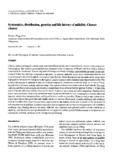Genetic assessment of milkfish (Chanos chanos Forsskal) stocks based on novel short tandem repeats for marker-aided broodstock management
- Global styles
- MLA
- Vancouver
- Elsevier - Harvard
- APA
- Help

View/
Date
2018Author
Page views
1,871ASFA keyword
AGROVOC keyword
Taxonomic term
Metadata
Show full item record
Share
Abstract
Milkfish hatchery broodstock are either from on-grown wild-caught or hatchery-produced fry/juveniles. To determine if a marker-assisted management scheme can be formulated for improved milkfish hatchery production, milkfish stocks were genetically characterized using nine novel short tandem repeats or microsatellites. Eight wild-bred Philippine stocks (CLA, CUR, CAM, SIH, SBH-I1, HH, PAL and ZH-P0), four hatchery-bred stocks (SBH-I2, SBH-D, BoH and ZH-F1), two farm stocks of known mixed lineages (SPH and BDH) and one Indonesian hatchery-bred stock (WJH) were assessed. WJH was included since milkfish fingerlings from Indonesia reared in Philippine farms could be developed into future broodstock. Mean allelic richness (Ar) was highest in wild-bred stocks (9.5) and lowest in hatchery-bred spawners (9.1). Mean expected heterozygosities (He) were relatively similar in all stocks with wild-bred stocks slightly higher (0.67) than the others. An analysis of molecular variance indicated significant yet low genetic differentiation among stocks (FST = 0.013; p = .000) where variation (98.6%) was explained by intra-stock differences. In some of the domesticated stocks, reductions in mean allelic richness were observed in first generation hatchery broodstock (e.g. ZH-F1; Ar = 8.3), compared with their founder stock (e.g. ZH-P0; Ar = 9.4). The Indonesian stock was similar to local wild-bred stocks based on genetic variability indices; thus, it might be likely that the local stocks’ fitness traits could be comparable with the imported milkfish stock which has been perceived to be better. The quality of locally available farmed milkfish and prospects of formulating a broodstock management scheme for the production of good quality milkfish seedstock are herewith discussed.
Suggested Citation
Romana-Eguia, M. R. R., Santos, B. S., Ikeda, M., Basiao, Z. U., & Kijima, A. (2018). Genetic assessment of milkfish (Chanos chanos Forsskal) stocks based on novel short tandem repeats for marker-aided broodstock management. Aquaculture Research , 49(4), 1557-1568. https://doi.org/10.1111/are.13610
Type
ArticleISSN
1355-557X; 1365-2109Collections
- Journal Articles [1258]
Related items
Showing items related by title, author, creator and subject.
-
Genetic assessment of philippine milkfish (Chanos chanos) stocks based on novel microsatellites for markeraided broodstock management
Romana-Eguia, Maria Rowena R. ; Santos, Brian S.; Ikeda, Minoru; Basiao, Zubaida U.; de Jesus-Ayson, Evelyn Grace T.; Kijima, Akihiro (Elsevier, 2017)
Reports on genetic diversity within/among milkfish populations using DNA markers are sparse. Earlier work dealt with evolutionary relationships among wild populations to define management units in the Indo-Pacific region ...
; Santos, Brian S.; Ikeda, Minoru; Basiao, Zubaida U.; de Jesus-Ayson, Evelyn Grace T.; Kijima, Akihiro (Elsevier, 2017)
Reports on genetic diversity within/among milkfish populations using DNA markers are sparse. Earlier work dealt with evolutionary relationships among wild populations to define management units in the Indo-Pacific region ... -
Systematics, distribution, genetics and life history of milkfish, Chanos chanos
Chanos chanos belongs to a monotypic gonorynchiform family and is most closely related to the freshwater Ostariophysi. The earliest gonorynchiforms occurred in the Cretaceous of Brazil and west Africa. Chanos occurred in ... -
Meristic variations in milkfish Chanos chanos from Philippine waters
Villaluz, Antonio C.; MacCrimmon, H. R. (Springer Verlag, 1988)Variations in meristic characters occur within and between samples of milkfish Chanos chanos (Forsskal) collected on June 1977 from five localities in Philippine waters. The unbranched anal and ventral fin rays are the ...





